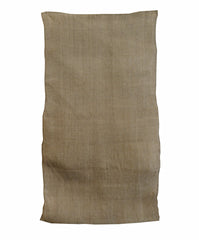A Fragment of Precious Bashofu: Plain Banana Fiber Cloth
late nineteenth, early twentieth century
22 1/2" x 11 3/4", 57 cm x 30 cm
Bashofu, or cloth woven from the fibers obtained from the leaf stems of the “thread banana” plant (ito basho) is synonymous with the Okinawan Islands where it was produced for at least 500 years.
From the essay, “Bashofu, The Mingei Movement, and the Creation of a New Okinawa” by Amanda Mayer Stinchecum published in the exhibition catalog “Material Choices: Refashioning Bast and Leaf Fibers in Asia and the Pacific“: “The first written evidence of bashofu in the Ryukyu Islands appears in an eyewitness account, dated 1546, reported by Pak Son and eleven other shipwrecked Koreans from Cheju Island. Reaching Ryukyu in 1542, they returned to Korean four years later. Their report includes descriptions of clothing, agriculture, and the cultivation of banana plants for making cloth:
The larger trees are the size of a house pillar. These are harvested, and the outermost skin stripped off. The sheaths inside are sorted into three grades. The fineness or coarseness of the finished cloth depends on whether the fiber is taken from the outer or inner layers. The innermost layer yields the thinnest and most lustrous fiber, and the color is as pure as snow. It is incomparable. Women’s clothing of high quality is made from this. (ikeya et al. 2005, 1:121)”
Bashofu is still very much appreciated all over the globe for its beauty and its depth of character. It is one of Japan’s most precious and esteemed textiles–it is difficult to convey the high admiration the Japanese hold for bashofu. Rare and historical examples are often prohibitively expensive–should they be brought to market–which is rare.
This is a nice example of an completely plain woven type. It was probably taken from a commoner's kimono and it is in used, good condition but with a tear to the bottom, right and some faint, small stains, all shown here.
Recommended.


